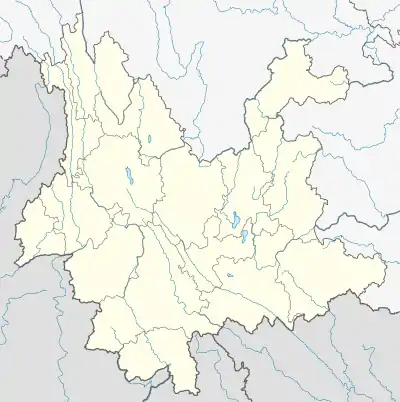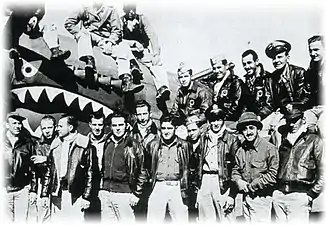Kunming Wujiaba International Airport
Kunming Wujiaba International Airport (IATA: KMG, ICAO: ZPPP) was the main airport serving Kunming, the capital of Yunnan Province, China. It is located 4 km (2.5 mi) south-east of metropolitan Kunming. Originally built in 1923, the airport had been renovated numerous times into a modern facility before closing on 28 June 2012. It was a major hub for China Eastern Airlines, Kunming Airlines, and Lucky Air. The airport has been replaced by the new Kunming Changshui International Airport. As of 2021, Wujiaba Airport has been demolished and the land will be fully redeveloped before the end of 2021.
Kunming Wujiaba International Airport | |||||||||||
|---|---|---|---|---|---|---|---|---|---|---|---|
_front.JPG.webp) | |||||||||||
| Summary | |||||||||||
| Airport type | Defunct | ||||||||||
| Serves | Kunming | ||||||||||
| Location | Kunming, Yunnan, China | ||||||||||
| Opened | 1923 | ||||||||||
| Closed | 28 June 2012 | ||||||||||
| Elevation AMSL | 1,895 m / 6,217 ft | ||||||||||
| Coordinates | 24°59′32″N 102°44′36″E | ||||||||||
| Map | |||||||||||
 KMG Location of the airport in Yunnan | |||||||||||
| Runways | |||||||||||
| |||||||||||
| Statistics (2011) | |||||||||||
| |||||||||||
| Kunming Wujiaba International Airport | |||||||||
|---|---|---|---|---|---|---|---|---|---|
| Traditional Chinese | 昆明巫家壩國際機場 | ||||||||
| Simplified Chinese | 昆明巫家坝国际机场 | ||||||||
| |||||||||
History

Wujiaba is among the oldest airports in China, with a history that can be traced back to about 100 years, and was first established into a military airbase and flight-training institute under the supervision of local warlord General Tang Jiyao in 1922; an additional 23 airports would be established in Yunnan from 1922-1929.[1]
The Sino-Japanese War was the beginning of World War II in Asia,[2] and following the Battles of Shanghai and Nanjing, the Chinese Central Air Force Academy had to be relocated from Jianqiao Airbase to the expanded Wujiaba Airport.[3] After a few years of support of the Chinese Air Force under the Sino-Soviet Cooperation in the War of Resistance against the Empire of Japan, the United States began to show earnest support for China's war effort with the oil embargo and asset freezing against Japan in 1941,[4] and Wujiaba became the base for the "legendary Flying Tigers", the American Volunteer Group (AVG) of combat airmen serving in the Chinese Air Force, led by Claire Lee Chennault just before the United States entered the war.[5] After the US entered the war in December 1941, and starting in 1942, Wujiaba Airport was the headquarters of numerous United States Army Air Forces units, including the Fourteenth Air Force and later the Tenth Air Force.
The USAAF Air Transport Command (ATC) established a major air transport facility at the airport, which connected flights west to Chabua Airfield, India, with other routes within China Jiangbei Airport (Chunking); Chengtu Air Base, and Banmaw Airport (Bhamo, Burma). After the war ended in 1945, a 1,390-mile (2,224 kilometer) route east to Clark Air Base in the Philippines was established. The route to Clark AB established a complete worldwide transport route for ATC.
The Flying Tigers Association visited in October 1982[6] and again in September 2005.[7]
Other facilities
Before merging into China Eastern Airlines, China Yunnan Airlines had its head office was located at the airport.[8]
Images
 Main building
Main building_front.JPG.webp) Front
Front Runway
Runway
Notes
- 杨亚伦(策划), 李晓明. "民航资源网". 民航资源网 机场新闻. Retrieved 4 December 2020.
从1922年巫家坝机场建成到1929年,云南又建成了23个机场,机场数翻了24倍,在中国机场建设史上绝无仅有,机场建设速度之快,创造了一个世界第一!抗战爆发后,出动150万民工再建28个机场,机场总数达到52个,密度之大,堪称亚洲第一,世界少有,云南由此成为中国最主要的抗日空军作战基地。与此同时,云南人民向抗日前线捐献的飞机数量,名列全国第一!修一个机场最快只用20多天...
- Sun, Lianggang. "Shanghai 1937 – Where World War II Began". SHANGHAI 1937: WHERE WORLD WAR II BEGAN. Retrieved 20 December 2020.
When did World War II begin? Shanghai 1937: Where World War II Began answers that question in a way most audiences will find surprising. Americans might say December 7, 1941… The day the Japanese Imperial Navy attacked the American naval base at Pearl Harbor, Hawaii. For Europeans, it was September 1, 1939… When Nazi Germany invaded Poland. But in China, people will tell you a different date. August 13, 1937.
- "朱青川:3次亲历日军飞机轰炸巫家坝机场_我身边的抗战英雄征集活动_共产党员网". www.12371.cn. Retrieved 16 November 2020.
- "United States freezes Japanese assets". HISTORY. Retrieved 16 November 2020.
- Rossi, J.R. (1998). "History: The Flying Tigers – American Volunteer Group – Chinese Air Force". AVG.
- Older, Chuck (1980s). "Hammerhead Stalls and Snap Rolls". The Flying Tigers – American Volunteer Group – Chinese Air Force.
- Rossi, Lydia. "OUR FABULOUS TRIP TO CHINA". The Flying Tigers – American Volunteer Group – Chinese Air Force.
- "World Airline Directory." Flight International. 1–7 April 1998. 57. "Wujaba [sic] Airport, Kunming, 650200, Yunnan Province, China"
References
![]() This article incorporates public domain material from the Air Force Historical Research Agency.
This article incorporates public domain material from the Air Force Historical Research Agency.
- Rossi, J.R. "AVG American Volunteer Group – Flying Tigers".
.jpg.webp)
.png.webp)